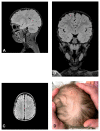The Impact of the IKBKG Gene on the Appearance of the Corpus Callosum Abnormalities in Incontinentia Pigmenti
- PMID: 37046518
- PMCID: PMC10093331
- DOI: 10.3390/diagnostics13071300
The Impact of the IKBKG Gene on the Appearance of the Corpus Callosum Abnormalities in Incontinentia Pigmenti
Abstract
Incontinentia pigmenti (IP) is a rare skin disease combined with anomalies of the teeth, eyes, and central nervous system (CNS). Mutations of the IKBKG gene are responsible for IP. Among the most frequent CNS abnormalities found in IP using magnetic resonance imaging (MRI) are corpus callosum (CC) abnormalities. The aim of the study was to determine the presence of CC abnormalities, their relationship with the IKBKG mutations, and the possible presence of mutations of other genes. A group of seven IP patients was examined. Analyses of the IKBKG gene and the X-chromosome inactivation pattern were performed, as well as MRI and whole exome sequencing (WES) with the focus on the genes relevant for neurodegeneration. WES analysis showed IKBKG mutation in all examined patients. A patient who had a mutation of a gene other than IKBKG was excluded from further study. Four of the seven patients had clinically diagnosed CNS anomalies; two out of four had MRI-diagnosed CC anomalies. The simultaneous presence of IKBKG mutation and CC abnormalities and the absence of other mutations indicate that IKBKG may be the cause of CC abnormalities and should be included in the list of genes responsible for CC abnormalities.
Keywords: IKBKG gene mutation; X-chromosome inactivation; central nervous system (CNS); corpus callosum; incontinentia pigmenti; magnetic resonance imaging (MRI); whole exome sequencing (WES).
Conflict of interest statement
The authors declare no conflict of interest.
Figures






Similar articles
-
Novel IKBKG gene mutations in incontinentia pigmenti: report of two cases.Front Med (Lausanne). 2023 Dec 19;10:1303590. doi: 10.3389/fmed.2023.1303590. eCollection 2023. Front Med (Lausanne). 2023. PMID: 38173938 Free PMC article.
-
Severe neuroimaging anomalies are usually associated with random X inactivation in leucocytes circulating DNA in X-linked dominant Incontinentia Pigmenti.Mol Genet Metab. 2017 Nov;122(3):140-144. doi: 10.1016/j.ymgme.2017.07.001. Epub 2017 Jul 10. Mol Genet Metab. 2017. PMID: 28711407
-
Molecular analysis of low-level mosaicism of the IKBKG mutation using the X Chromosome Inactivation pattern in Incontinentia Pigmenti.Mol Genet Genomic Med. 2020 Dec;8(12):e1531. doi: 10.1002/mgg3.1531. Epub 2020 Oct 21. Mol Genet Genomic Med. 2020. PMID: 33085210 Free PMC article.
-
Uncovering incontinentia pigmenti: From DNA sequence to pathophysiology.Front Pediatr. 2022 Sep 6;10:900606. doi: 10.3389/fped.2022.900606. eCollection 2022. Front Pediatr. 2022. PMID: 36147820 Free PMC article. Review.
-
Incontinentia Pigmenti.Actas Dermosifiliogr (Engl Ed). 2019 May;110(4):273-278. doi: 10.1016/j.ad.2018.10.004. Epub 2019 Jan 17. Actas Dermosifiliogr (Engl Ed). 2019. PMID: 30660327 Review. English, Spanish.
Cited by
-
Case Report: Diagnosis and treatment of incontinentia pigmenti with central nervous system anomalies in one patient.Front Pediatr. 2025 Jan 15;12:1490816. doi: 10.3389/fped.2024.1490816. eCollection 2024. Front Pediatr. 2025. PMID: 39882206 Free PMC article.
-
Bioinformatic Analysis of IKK Complex Genes Expression in Selected Gastrointestinal Cancers.Int J Mol Sci. 2024 Sep 12;25(18):9868. doi: 10.3390/ijms25189868. Int J Mol Sci. 2024. PMID: 39337357 Free PMC article.
-
Evaluating TAB2, IKBKB, and IKBKG Gene Polymorphisms and Serum Protein Levels and Their Association with Age-Related Macular Degeneration and Its Treatment Efficiency.Medicina (Kaunas). 2024 Dec 16;60(12):2072. doi: 10.3390/medicina60122072. Medicina (Kaunas). 2024. PMID: 39768951 Free PMC article.
References
-
- Orphanet Report Series. Number 1, 2022. Prevalence of Rare Diseases. [(accessed on 2 January 2023)]. Available online: https://www.orpha.net/orphacom/cahiers/docs/GB/Prevalence_of_rare_diseas....
-
- Scheuerle A., Ursini M.V. In: Incontinentia Pigmenti. Adam M.P., Mirzaa G.M., Pagon R.A., Wallace S.E., editors. University of Washington; Seattle, WA, USA: [(accessed on 2 January 2023)]. 1993–2023. Available online: https://www.ncbi.nlh.nih.gov/books/NBK1472. - PubMed
-
- Smahi A., Courtois G., Vabres P., Yamaoka S., Heuertz S., Munnich A., Israël A., Heiss N.S., Klauck S.M., Kioschis P., et al. Genomic rearrangement in NEMO impairs NF-κB activation and is a cause of incontinentia pigmenti. The International Incontinentia Pigmenti (IP) Consortium. Nature. 2000;405:466–472. doi: 10.1038/35013114. - DOI - PubMed
Grants and funding
LinkOut - more resources
Full Text Sources
Miscellaneous

